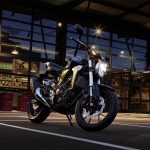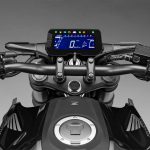The new ‘sport naked’ family from Honda goes for the passionate beginners
The 2018 CB300R is part of a new ‘sport naked’ family introduced by Honda. The new family includes the CB1000R and CB125R and tries to offer the excitement of two wheels into a lightweight form, perfect for newcomers.
If rookies could start with the CB125R, more advanced riders could go for the new CB300R as a stepping stone after a 125cc machine. It’s designed to help newer riders develop their riding skills and enjoyment, Honda says, and, looking at their specs, they might be just right.

The CB300R has many of the premium features found on its larger capacity siblings. It also injects a fresh new style on to Europe’s city streets, with its ‘Neo Sports Café’ minimalist, bare-boned attitude shared with both its 1000 and 125cc stablemates.
Honda CB300R – what's new
The CB300R weights 143kg wet, so it's not a very heavy machine. A new frame mixes pressed and tubular steel for a tuned rigidity balance for better handling. The CB300R also features 41mm USD forks with radial-mount 4-piston caliper, hubless floating front disc, IMU-based ABS and Dunlop radial tyres.

Some other new features are usually found on much larger machines such as the tapered rubber-mounted aluminium handlebar, LCD instrument display and full LED lighting.
Honda CB300R – main features
- Industrial minimal styling takes cues from the 2018 CB1000R
- Lightweight frame mixes tubular and pressed steel
- 41mm USD front forks and irregular-cross section steel swingarm
- Radial-mount 4-piston caliper and hubless 296mm floating front disc
- Full LED lighting and LCD instrumentation
- IMU-based ABS
The single rear shock offers 5-step spring preload adjustment. A 49.6% front/50.4% rear weight bias provides a positive feel for front-end grip and easy steering which is also helped by the low, 143kg wet weight and compact 1352mm wheelbase. The aluminium fat bar-style handlebars turn through a 40° radius and the 2.3m turning radius guarantees easy passage in jammed city traffic. Seat height is 799mm.

The front 296mm hubless floating disc is worked by a radial-mount Nissin 4-piston caliper; the rear 220mm disc a single piston caliper. Both are modulated by 2-channel ABS. The high specification system works through an IMU (Inertial Measurement Unit) to give precise front to rear distribution of ABS operation depending on the vehicle behaviour The 150/60R-17 Dunlop radial rear tyre is matched to a 110/70R-17 radial front.

A thin (23.5mm) lightweight (230g) full function LCD instrument display provides speed, engine rpm, fuel level and gear position simply, with warning lights arrayed across the top. Full LED lighting – including indicators – adds a premium feel and contributes to mass centralisation. The headlight uses a dual bar light signature, upper for low beam and lower for high beam and the taillight is the thinnest ever mounted on a Honda motorcycle.

The 10L fuel cell is hidden underneath an angular cover and shrouds and houses an aircraft-style filler cap. With fuel economy of 30.2km/l (WMTC mode), the CB300R can cover over 300km from full.

The CB300R’s compact 286cc DOHC 4-valve liquid-cooled single cylinder engine – shared with the CBR300R – is already appreciated for its free-revving and responsive nature. And while that free-spinning character can get the adrenaline pumping as revs rise, it’s also an engine that works well in ‘real-world’ road riding conditions, both around town and out on the highway.

Peak power of 23.1kW arrives @ 8,500rpm, with peak torque of 27.5Nm delivered @ 7,500rpm. The 6-speed gearbox offers an even spread of gears for strong acceleration – the CB300R will cover 0-200m in just 9.2s
So, would you choose this CB300R as your second bike? Let us know in the comments below.























